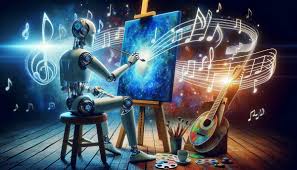
Generative AI tools are redefining how artists create. From text-to-image platforms like DALL·E and Midjourney to interactive sound generators and code-based art, today’s creatives are blending algorithms with imagination. These tools don’t replace the artist — they expand the toolkit.
Artists now use prompts as brushes, training AI models on personal styles or cultural themes to produce surreal visuals, futuristic portraits, or dreamlike landscapes. For instance, digital artists can generate multiple visual drafts in minutes, refining their vision rapidly. Others are turning AI-generated sketches into large-scale paintings, sculptures, or even immersive installations.
This fusion has created a new kind of artistic dialogue. It’s no longer just the human mind at work, but a collaboration with intelligent systems. Many contemporary creators see AI as a co-author rather than a threat. They explore concepts of authorship, originality, and ethics in a world where machines participate in creation.
At the same time, debates continue about creative ownership and artistic labor. Yet, it’s clear that generative tools have unlocked a playground for bold experimentation. For a generation of digital-native artists, AI is not a trend—it’s a brushstroke of the future.